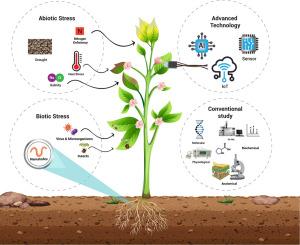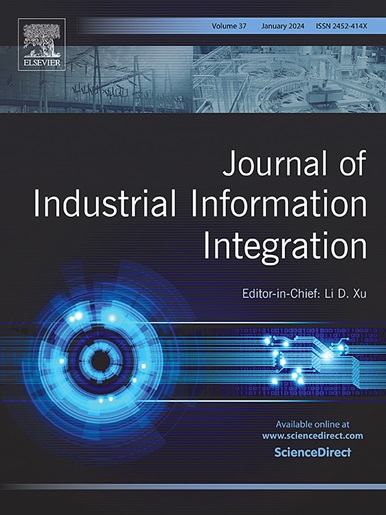A comprehensive review of AI-driven plant stress monitoring and embedded sensor technology: Agriculture 5.0
IF 10.4
1区 计算机科学
Q1 COMPUTER SCIENCE, INTERDISCIPLINARY APPLICATIONS
引用次数: 0
Abstract
To address the future demand for food, fiber, and fuel, crop production must double by 2050. It requires reshaping Agriculture 5.0 by overcoming typical limitations in crop yields caused by biotic and abiotic stresses while integrating computational power, artificial intelligence (AI), and sensor technology. To date, many studies have explored AI applications in plant stress monitoring and detection, and a critical synthesis of algorithm suitability, sensor integration, and critical assessment of industrial scalability is still lacking. Thus, this review systematically evaluates 175 peer-reviewed articles (from an initial pool of 687, published between 2010 and 2024) to identify trends, performance benchmarks, and integration challenges in AI-driven plant stress detection. The trend analysis revealed a substantial increase in AI and sensor applications for plant stress monitoring, specifically after COVID-19, although ∼67 % of studies limit classification tasks to 5 or fewer classes, often lacking field validation. CNN-based classification models (e.g., VGG16, VGG19, and ResNet50) consistently perform well across stress types, whereas detection-focused models such as YOLO and lightweight architectures such as MobileNet show greater variability, particularly in biotic stress identification tasks. Traditional machine learning methods, such as support vector machines, decision trees, and k-nearest neighbors remain relevant for structured, low-resolution data, especially under constrained conditions. Optimization algorithms such as stochastic gradient descent (biotic stress) and Adam (abiotic stress) are widely used. Advancements in sensor technologies, including hyperspectral imaging, volatile organic compound (VOC) detection via electronic noses, and real-time monitoring systems enable noninvasive and continuous stress detection. In parallel, the deployment of industrial robots equipped with embedded AI and multimodal sensors allows for automated, high-frequency stress surveillance and precision intervention in commercial-scale crop systems. Aligning AI models with specific sensor modalities is pivotal for developing scalable, interoperable, and industrial-grade monitoring systems.

人工智能驱动的植物胁迫监测和嵌入式传感器技术综述:农业5.0
为了满足未来对食物、纤维和燃料的需求,农作物产量必须在2050年前翻一番。它需要重塑农业5.0,克服由生物和非生物压力造成的典型作物产量限制,同时整合计算能力、人工智能(AI)和传感器技术。迄今为止,许多研究已经探索了人工智能在植物胁迫监测和检测中的应用,但仍然缺乏对算法适用性、传感器集成和工业可扩展性的关键综合评估。因此,本综述系统地评估了175篇同行评议的文章(来自2010年至2024年间发表的687篇初始论文),以确定人工智能驱动的植物胁迫检测的趋势、性能基准和集成挑战。趋势分析显示,人工智能和传感器在植物胁迫监测中的应用大幅增加,特别是在COVID-19之后,尽管约67%的研究将分类任务限制在5个或更少的类别,通常缺乏现场验证。基于cnn的分类模型(如VGG16、VGG19和ResNet50)在各种压力类型中都表现良好,而以检测为中心的模型(如YOLO)和轻量级架构(如MobileNet)表现出更大的可变性,特别是在生物压力识别任务中。传统的机器学习方法,如支持向量机、决策树和k近邻仍然适用于结构化、低分辨率数据,特别是在受限条件下。优化算法如随机梯度下降(生物压力)和亚当(非生物压力)被广泛使用。传感器技术的进步,包括高光谱成像、通过电子鼻检测挥发性有机化合物(VOC)和实时监测系统,使非侵入性和连续的应力检测成为可能。与此同时,配备嵌入式人工智能和多模态传感器的工业机器人的部署允许在商业规模的作物系统中进行自动化、高频应力监测和精确干预。将人工智能模型与特定传感器模式相结合,对于开发可扩展、可互操作的工业级监控系统至关重要。
本文章由计算机程序翻译,如有差异,请以英文原文为准。
求助全文
约1分钟内获得全文
求助全文
来源期刊

Journal of Industrial Information Integration
Decision Sciences-Information Systems and Management
CiteScore
22.30
自引率
13.40%
发文量
100
期刊介绍:
The Journal of Industrial Information Integration focuses on the industry's transition towards industrial integration and informatization, covering not only hardware and software but also information integration. It serves as a platform for promoting advances in industrial information integration, addressing challenges, issues, and solutions in an interdisciplinary forum for researchers, practitioners, and policy makers.
The Journal of Industrial Information Integration welcomes papers on foundational, technical, and practical aspects of industrial information integration, emphasizing the complex and cross-disciplinary topics that arise in industrial integration. Techniques from mathematical science, computer science, computer engineering, electrical and electronic engineering, manufacturing engineering, and engineering management are crucial in this context.
 求助内容:
求助内容: 应助结果提醒方式:
应助结果提醒方式:


